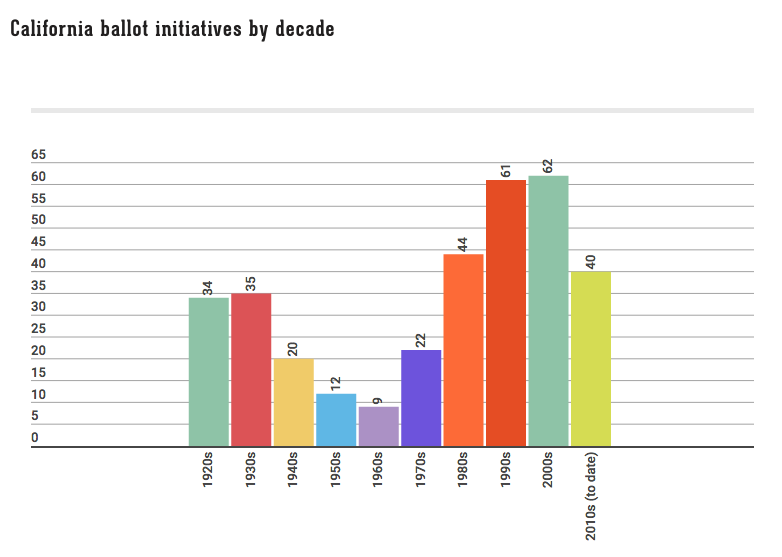Protracted policy questions. Big-money battles. Contradictory proposals that are difficult to discern. It’s shaping up to be an all-too-typical fall election—once again confronting California voters with an unwieldy ballot.
This wasn’t supposed to happen. After polls confirmed that California voters were frustrated by ballot overload, lawmakers two years ago made changes aimed at pre-empting at least some initiatives from landing on the ballot, and improving those that do. One change gave the Legislature extra time to hold hearings and try to compromise with interest groups pitching complex issues.
“We’re taking an important step to modernize and strengthen direct democracy,” Gov. Jerry Brown said as he signed the changes into law in 2014.
Yet just two years later, Californians face a messy ballot that is likely to inspire the same frustrations the changes were meant to resolve. In November, voters will decide the fate of 17 ballot measures, including conflicting approaches to the death penalty, a proposal specific to the pornography industry, and an initiative to legalize recreational marijuana that runs 65 pages long.
So are the reforms really working? With one major exception, the answer is “not yet.”
The exception: Elected officials reached a significant compromise this year with labor unions backing an initiative to raise the statewide minimum wage to $15 an hour. The proponents pulled their measure off the ballot after Brown signed a bill that raised the wage while providing safeguards for the state budget that weren’t in the initiative.
But other than on that issue, “it’s really hard to find an example this year of the (initiative) reforms making a difference,” said Mark Baldassare, president of the Public Policy Institute of California. “The reforms were sensible ones. But… this election is not a sea change.”

Many factors contributed to the long ballot this year. It’s easier to qualify an initiative this time around because the formula for how many signatures are required is based on the previous state election’s turnout, which in 2014 was low. Also many liberal interests prefer to put their issues before voters in a presidential election year, when Democratic turnout is high. Some policies, like the death penalty, can be changed only by voters because they were created through initiatives in the first place. And at least two measures — one challenging a plastic bag ban and another advocating for condoms in pornography – landed on the ballot because interest groups are dissatisfied with the Legislature’s decisions.
Most initiatives fail because voters opt for “no” when they feel overwhelmed by long ballots and confusing campaigns, Baldassare said. He said he expected more compromises between lawmakers and initiative proponents to keep some issues off the ballot, particularly marijuana legalization, gun control and school construction. Instead, the November ballot has a school bond the governor opposes and a gun control measure lawmakers tried to replace with legislation. Lawmakers largely took a pass on the issue of recreational marijuana, putting that question to voters too.
“There were plenty of opportunities this year for really looking under the hood of the initiative by the Legislature to see if there would be opportunities for compromise or re-writing or revising,” Baldassare said. “Why didn’t it work in more cases?”
Those who supported the changes in 2014 say it’s too soon to say they’re not working.
“One (election) cycle is not enough to render a definitive judgment,” said Darrell Steinberg (D-Sacramento), who carried the bill that made the changes during his final year as leader of the state Senate.
“I am confident that over time (the bill) will be the safety valve that we intended it to be. There will be numerous instances where initiative proponents and representative government are able to work out their differences and create a law that is good public policy.”
Steinberg’s bill was supposed to improve the process by giving interest groups and lawmakers more opportunities for give and take, so that initiatives could be changed before they reach voters or lawmakers could come up with solutions that would avoid the ballot altogether. It created a new public review period to allow for amendments at the early stage of the initiative process, extended the time period for gathering signatures, gave proponents more time to remove measures from the ballot and gave lawmakers more time to hold hearings about the initiatives
Backers of an initiative to extend income taxes used the new review period to tweak their measure early this year after criticism from Brown.
The changes helped create a positive climate for negotiation on another issue this year, said Sen. Bob Hertzberg (D-Los Angeles), who advocated for the reforms two years ago. After proponents started gathering signatures for an initiative to give the public better information about lobbying and political fundraising, Hertzberg worked with them and introduced a similar bill. The backers dropped the initiative, though the timing was early enough that the same events could have unfolded under the old system.
“This is a change in how government works and it’s going to take longer than we anticipated, but I do think it has value,” Hertzberg said.
He acknowledged that the new process could have worked better if the Legislature had taken advantage of the longer time period for reviewing measures. Instead, many of the hearings were held just a few weeks before the deadline, reducing the likelihood that any meaningful changes could come out of them.
“Waiting until the last minute did end up killing the opportunity for negotiations,” said Kathay Feng, executive director of California Common Cause, an open-government group that supported the 2014 changes.
For the initiative reforms to work, she said lawmakers will have to “learn a new role—and that is to play the role of facilitator of discussions and negotiations and not just one of the warring parties.”

